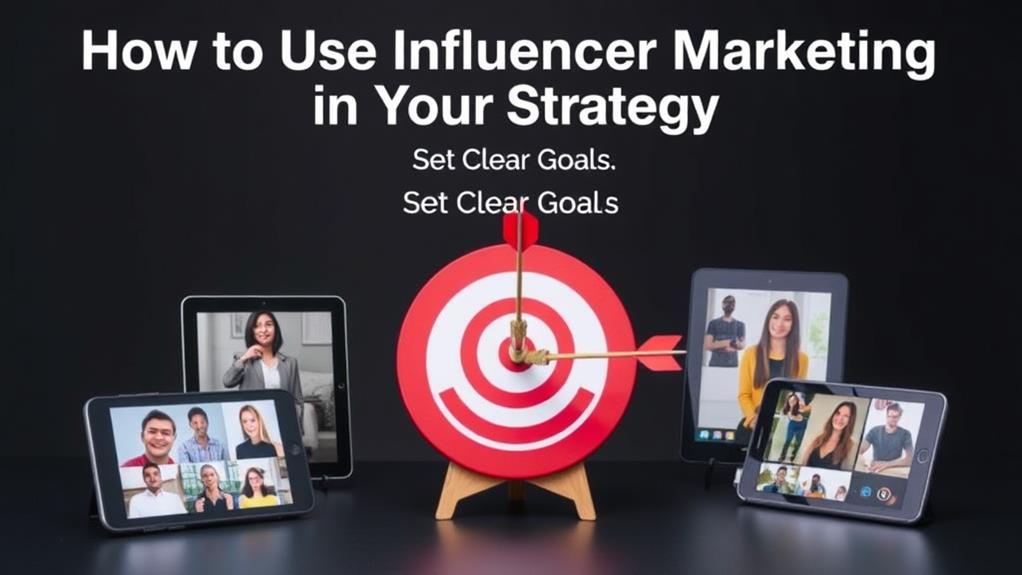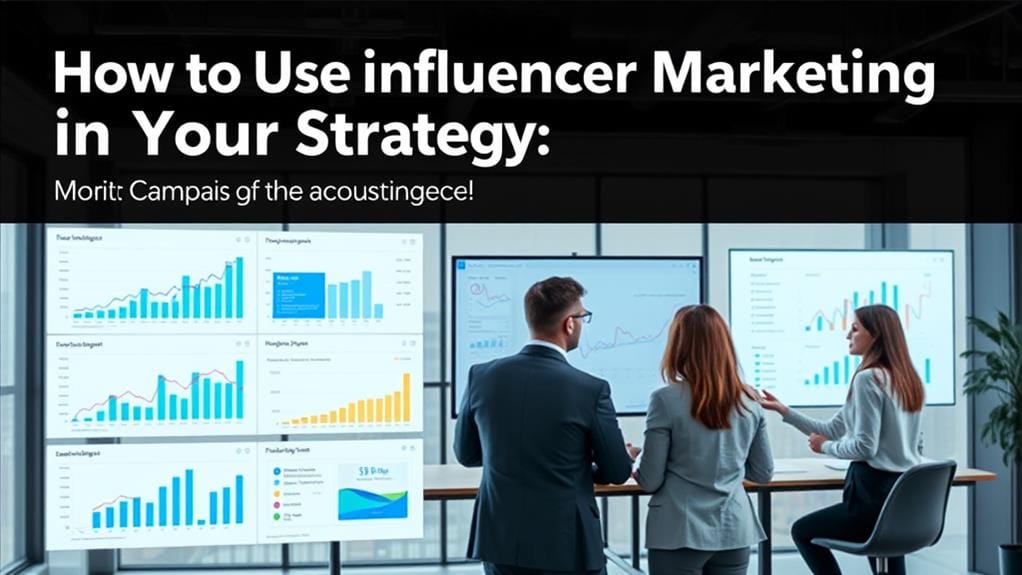How to Use Influencer Marketing in Your Strategy
To effectively integrate influencer marketing into your strategy, begin by understanding your audience's demographics and engagement habits. Identify influencers whose values align with your brand, ensuring genuine connections with your target market. Set clear goals, such as conversion rates or engagement milestones, and monitor performance through data-driven metrics. Foster authentic relationships with influencers, empowering them to produce relatable content. Diversify your approach by leveraging multiple platforms for wider reach. Finally, be adaptable—regularly refine your tactics based on audience feedback and emerging trends to optimize campaign success. For deeper insights into influencer marketing strategies, further exploration is essential.
Key Takeaways
- Define your target audience to align with influencers sharing similar values and interests for effective marketing strategies.
- Analyze engagement metrics to evaluate influencer effectiveness and ensure meaningful interactions with your demographic.
- Set clear goals and Key Performance Indicators (KPIs) to measure the success of your influencer marketing campaigns.
- Foster genuine relationships with influencers by empowering them to create authentic content that resonates with their followers.
- Adjust your strategy based on performance data and audience feedback to optimize campaigns and maximize engagement.
Understand Your Audience

Understanding your audience is the foundational pillar of any effective influencer marketing strategy. By recognizing the specific audience demographics and exploring consumer behavior, brands can tailor their messaging and approach to resonate deeply with their target market.
In today's digital landscape, consumers prioritize authenticity and meaningful connections, making it essential for businesses to articulate their value propositions clearly and compellingly.
Data reveals that 63% of consumers consider the opinions of online influencers significant when making purchasing decisions. This statistic highlights the importance of aligning with influencers who already connect with your audience.
Exploring demographic factors—such as age, gender, location, and interests—enables brands to identify the most relevant influencers who can communicate their message effectively.
Furthermore, understanding consumer behavior offers insight into how potential customers interact with content and make choices. For instance, analyzing past engagement metrics can uncover trends that inform when and how to deploy marketing campaigns.
A strategic approach requires not only a knowledge of what your audience seeks but also the ability to perceive shifts in preferences and behaviors over time.
Ultimately, a successful influencer marketing strategy hinges on a profound understanding of who the audience is and what drives them. By leveraging data-driven insights into audience demographics and consumer behavior, brands can foster genuine connections with their potential customers, thereby amplifying brand loyalty and encouraging the freedom of choice inherent in today's marketplace.
Identify the Right Influencers
Identifying the right influencers is essential for maximizing the impact of your marketing strategy, starting with a clear definition of your target audience.
By analyzing influencer engagement metrics, brands can guarantee they partner with individuals who not only reach the intended demographic but also foster meaningful interactions.
In addition, evaluating brand alignment helps to create authentic partnerships that resonate with both the influencer's followers and your brand mission.
Define Your Target Audience
A well-defined target audience is the cornerstone of a successful influencer marketing strategy. Understanding your audience's demographics and behavioral insights allows you to connect more authentically with potential customers. This clarity helps in selecting influencers whose followers align with your brand's ethos, ultimately enhancing campaign effectiveness.
To effectively define your target audience, consider the following key factors:
- Age Range: Pinpoint the age groups that resonate with your product.
- Gender: Analyze whether your offering appeals primarily to men, women, or all genders.
- Location: Investigate geographic trends that can influence buying behavior.
- Interests: Understand what hobbies, lifestyles, and values inspire your audience.
- Buying Behavior: Evaluate how frequently and through which channels your target audience shops.
Utilizing data-driven insights, you can tailor your influencer partnerships to those who genuinely reflect your brand's mission. This strategic alignment not only enhances engagement but also nurtures a sense of freedom among your customers, allowing them to relate personally to your narrative.
Analyze Influencer Engagement Metrics
Five key engagement metrics are vital for evaluating the effectiveness of potential influencers in your marketing strategy. By analyzing these metrics, you can pinpoint influencers who resonate with your target audience while maximizing your return on investment.
First, assess engagement rates, which reflect how actively an influencer's audience interacts with their content. A high engagement rate indicates genuine audience interest, important for fostering authentic connections with your brand.
Second, explore audience demographics; understanding the age, gender, location, and interests of an influencer's followers guarantees alignment with your ideal customer profile.
Additionally, track comments and shares to gauge the depth of engagement. This data will reveal whether followers are inclined to participate in discussions or amplify messages, enhancing your brand's reach.
Fourth, evaluate the growth of the influencer's following over time; consistent growth suggests ongoing relevance and credibility.
Evaluate Brand Alignment
Selecting influencers who genuinely align with your brand values is essential for effective marketing. Misalignment can not only dilute your message but also negatively impact audience perception, leading to skepticism about your authenticity.
To identify the right influencers, consider the following criteria:
- Shared Values: Guarantee influencers embody the same principles your brand champions.
- Audience Overlap: Evaluate if their followers mirror your target demographic.
- Content Style: Analyze the influencer's content to see if it resonates with your brand's voice.
- Engagement Authenticity: Investigate their engagement metrics to confirm genuine interactions with their audience.
- Reputation and Trust: Assess their standing within the industry and among consumers to gauge potential influence.
Set Clear Goals

Setting clear goals is essential for a successful influencer marketing strategy, beginning with a precise definition of the target audience.
Identifying who you want to reach will inform the selection of influencers and content direction, ultimately enhancing engagement effectiveness.
Additionally, establishing Key Performance Indicators (KPIs) allows for measurable outcomes, enabling ongoing assessment and strategic refinement of the campaign.
Define Target Audience
Defining a target audience is a cornerstone of an effective influencer marketing strategy, as it establishes the foundation upon which all subsequent efforts are built.
Understanding your audience demographics and engaging in psychographic profiling are essential tasks that lead to a more targeted approach in your campaigns. With clarity on who you are aiming to reach, you can select influencers whose followers align with your ideal customer profile.
To define your target audience effectively, consider these critical elements:
- Age: Understand the age groups that resonate with your brand.
- Gender: Tailor your messaging based on gender preferences.
- Location: Identify geographical zones that matter for your products or services.
- Interests: Align your strategy with the hobbies and passions of your potential customers.
- Values: Recognize the beliefs and attitudes that drive your audience's purchasing decisions.
Establish Key Performance Indicators
Establishing key performance indicators (KPIs) is essential for measuring the success of your influencer marketing campaigns and ensuring alignment with overarching business objectives. Clear KPIs help define campaign objectives and provide a framework to evaluate the effectiveness of your strategies.
By setting specific, measurable targets, you can monitor progress and adapt your approach, fostering a sense of freedom to explore innovative tactics while maintaining focus on desired outcomes.
When establishing KPIs, consider both quantitative and qualitative metrics, as they offer a balanced view of campaign performance. Common performance benchmarks include engagement rates, conversion metrics, brand awareness levels, and audience growth.
For instance, if your objective is to boost product awareness, track metrics such as reach and impressions. Conversely, if the goal is to drive sales, monitor conversion rates and ROI closely.
Aligning these indicators with your business goals allows for agile marketing decisions that resonate with your audience. Through regular analysis of performance data, you can refine your influencer partnerships and maximize the impact of your campaigns, ensuring a strategic approach that meets both brand aspirations and consumer demands.
Build Genuine Relationships
How can brands cultivate authentic connections in the crowded space of influencer marketing? The key lies in prioritizing relationship authenticity and fostering influencer trust. When brands approach partnerships as collaborations rather than transactions, they create a foundation for genuine relationships that resonate with audiences, driving brand loyalty and engagement.
To effectively build these relationships, consider the following strategies:
- Prioritize Values: Align with influencers who share your brand's values and mission. This congruence fosters a more organic connection that resonates with their audience.
- Engage Meaningfully: Consistently interact with influencers beyond campaign-specific communications. Comment on their posts, share their content, or simply express appreciation.
- Empower Creativity: Allow influencers to express their creativity. Granting them freedom to create authentic content not only validates their expertise but also enhances relatability with their followers.
- Provide Transparency: Openly communicate your brand's goals, expectations, and metrics for success. This honesty builds trust and facilitates a long-term partnership.
- Offer Mutual Benefits: Guarantee that both parties derive value from the relationship. Whether through fair compensation or exposure opportunities, mutual benefits reinforce the partnership's authenticity.
Create Engaging Content

Engaging content is essential for capturing the attention of audiences in an era saturated with digital information. To maximize the effectiveness of influencer marketing, brands must focus on diverse content types that resonate with their target demographic. Utilizing storytelling techniques can enhance relatability, weaving compelling narratives that showcase brand values while aligning with campaign themes.
Employing striking visual aesthetics and leveraging multimedia elements—such as videos, infographics, and interactive graphics—can increase audience interaction and retention. Research indicates that visuals enhance comprehension by up to 400%. This statistic underscores the need for brands to adopt creative formats that not only attract attention but also foster engagement.
Maintaining a consistent brand voice across these various content types can instill a sense of trust and familiarity among audiences. However, authenticity factors are critical; partnerships with influencers should feel seamless, ensuring that content remains genuine and aligned with the influencer's persona. This authenticity enhances the content's viral potential, encouraging shares and discussions, thereby amplifying reach.
To create truly engaging content, brands should encourage audience interaction, prompting followers to participate in challenges or share their experiences. This strategy not only deepens engagement but also reinforces community development around the brand.
Leverage Multiple Platforms
The success of an influencer marketing strategy often hinges on a brand's ability to leverage multiple platforms effectively. By adopting a cross platform synergy approach, brands can enhance their reach, amplify engagement, and optimize personalization for their target audiences.
Different platforms attract distinct demographics, making audience segmentation essential. This enables brands to tailor messages that resonate specifically with varying segments across platforms.
Key strategies to take into account include:
- Identifying platform suitability: Understand where your audience spends their time—be it Instagram, TikTok, YouTube, or any other social media outlet.
- Diversifying content types: Utilize each platform's strengths; for example, engage audiences with short, impactful videos on TikTok while delivering in-depth tutorials on YouTube.
- Establishing a cohesive brand message: Confirm that while content is tailored for each platform, the core message remains consistent to bolster brand identity.
- Engaging influencers across platforms: Partnering with a range of influencers who excel in different environments can broaden your outreach and tap into their followers' loyalty.
- Cross-promoting content: Encourage influencers to share your brand's message across various platforms to maximize visibility and reinforce your campaign.
Monitor Campaign Performance

Monitoring campaign performance is integral to evaluating the effectiveness of an influencer marketing strategy. By utilizing robust campaign analytics, brands can gain invaluable insights into how well their collaborations resonate with target audiences. This process involves tracking key performance benchmarks such as engagement rates, reach, conversions, and overall return on investment (ROI).
A well-structured analytics framework allows marketers to dissect data and discern which influencers are driving the most significant impact. Metrics such as click-through rates and impressions provide clarity on audience engagement, while conversion tracking reveals the tangible effects of influencer-driven traffic on sales. Measuring these indicators helps identify successful strategies and opportunities for improvement.
Additionally, comparative performance analysis against established benchmarks assists in evaluating campaign health. Understanding industry standards enables brands to set realistic expectations and goals, catering to their unique market positioning. For instance, aligning influence-driven metrics with digital marketing objectives fosters a more cohesive strategy and empowers brands to pivot when necessary.
The data collected from campaign analytics is not merely about numbers; it embodies freedom in decision-making. By understanding what works and why, marketers can liberate their strategies from ineffective practices and focus their resources where they yield the highest returns. Consequently, consistent monitoring transforms influencer partnerships into powerful tools for brand growth, enabling marketers to celebrate successes and learn from setbacks thoughtfully.
Ultimately, evaluating campaign performance is not just strategic—it is essential for mastering the dynamic landscape of influencer marketing.
Adjust Your Strategy
In light of the insights garnered from campaign performance analytics, adjusting your influencer marketing strategy becomes a critical step in optimizing outcomes.
As you explore the data, it is crucial to be proactive in refining your approach to not only stay relevant but to gain a competitive edge in the constantly changing landscape.
To effectively adjust your strategy, consider the following actionable steps:
- Adjust Messaging: Tailor your communication to resonate better with the identified audience segments based on their behavior and engagement metrics.
- Refine Tactics: Shift away from underperforming influencers and reallocate resources to those who have demonstrated higher engagement and conversion rates.
- Experiment with Content Formats: Analyze which types of content (videos, stories, blogs) drive the highest engagement and consider integrating more of those formats.
- Target New Audiences: Expand your collaborations by exploring influencers who connect with previously untargeted demographics.
- Monitor Trends and Feedback: Stay attuned to evolving trends and audience preferences by actively soliciting feedback and making real-time adjustments.
With these strategic adjustments, you create a dynamic influencer marketing approach that not only boosts current campaign performance but also lays a foundation for long-term success.
By continually adjusting your messaging and refining tactics, you empower your brand to thrive in an era that values authenticity and engagement.
The ability to adapt your strategy decisively will ultimately lead to a more robust connection with your audience, driving measurable results and fostering greater freedom in your marketing endeavors.
Frequently Asked Questions
How Do I Budget for Influencer Marketing Campaigns?
Budgeting for influencer marketing campaigns requires a strategic approach that includes defining clear objectives and selecting appropriate influencer compensation strategies.
Analyze past campaign performance metrics to estimate potential return on investment, ensuring resources are allocated efficiently.
Consider factors such as influencer reach, engagement rates, and audience alignment to guide your financial commitments.
This data-driven methodology empowers brands to harness flexibility while maximizing impact in their influencer partnerships, achieving desired outcomes with confidence.
What Types of Influencers Should I Consider Partnering With?
An impressive 89% of marketers find ROI from influencer marketing comparable to or better than other channels.
When considering influencer partnerships, evaluate micro influencers for their authentic engagement, brand ambassadors for long-term loyalty, and niche experts for specialized reach.
Additionally, social media personalities and content creators can amplify your message, while lifestyle influencers enhance relatability.
Industry leaders can lend credibility, whereas celebrity partners can dramatically extend your campaign's visibility, offering diverse strategies for engagement.
How Can I Measure an Influencer's Authenticity?
Measuring an influencer's authenticity is vital for an effective collaboration. Begin by analyzing engagement metrics, such as likes, comments, and shares, to evaluate audience interaction.
Additionally, scrutinize audience demographics—genuine influencers often have diverse, niche communities that align with their content.
Tools like social media analytics and influencer platforms can further provide insights into follower quality, revealing potential discrepancies.
Ultimately, a data-driven approach guarantees strategic partnerships that resonate with your brand's values and objectives.
What Legal Considerations Should I Be Aware Of?
In the landscape of influencer marketing, steering through legal considerations can be as intricate as it is crucial.
While creative freedom is paramount, adherence to disclosure guidelines safeguards authenticity and transparency.
Additionally, establishing clear contract terms is essential to delineating expectations and responsibilities.
How Do I Handle Negative Feedback From Influencers or Their Followers?
Handling negative feedback from influencers or their followers requires a blend of influencer response strategies and follower engagement techniques.
First, address the concern promptly and professionally, demonstrating accountability.
Utilize social media channels to clarify misunderstandings and reinforce brand values.
Engage directly with followers by encouraging dialogue and feedback, showcasing openness and transparency.
This not only mitigates potential damage but also strengthens community trust, ultimately fostering a more resilient brand image.
Conclusion
To summarize, influencer marketing represents a dynamic strategy that necessitates an extensive understanding of audience demographics and preferences. The selection of appropriate influencers, coupled with clearly defined objectives, facilitates successful engagement. Additionally, fostering authentic relationships and producing compelling content can greatly enhance brand visibility across diverse platforms. Continuous monitoring of campaign performance enables timely adjustments, supporting the premise that iterative optimization is key to maximizing the effectiveness of influencer marketing initiatives. Statistical evidence underscores its growing impact on consumer behavior and brand loyalty.




